
BY ANTHONY AVILLO
Consider the following line-of-duty death (LODD) incidents:
- Firefighters extinguish a fire in a building that was already gutted and had been the scene of previous fires. Shortly after putting the fire under control, a wall collapses, killing a firefighter and injuring many others.
- Firefighters enter an exposure building adjacent to a four-story shell of a factory at which a fire completely gutted the interior and caused a total floor collapse. One of the remaining free-standing walls collapsed onto the exposure, killing two firefighters and injuring several more.
- Firefighters re-enter a church that had been completely gutted by fire. Shortly thereafter, the steeple collapsed, killing two firefighters and injuring almost 30.
- After using a defensive attack to extinguish much of the fire, companies entered a building to perform overhaul, during which the roof collapsed. One firefighter was killed and several injured. The building was vacant and dilapidated before the fire ever occurred.
- A potential close call. North Hudson (NJ) Regional Fire Department members were operating at a mutual-aid fire, an all-night affair in which we were babysitting a defensive operation at one of the exposure buildings. As the sun rose, a three-story building with no roof or top floor and which heavy-caliber streams had battered all night was apparently going to get a visit by a line of fresh troops. These companies were outfitted in full gear and an assortment of tools. They were looking to enter the structure. They were, as they said, going to go in and “mop up,” as they did not want to be there all day. We were stunned, since the building deserved no better treatment than a “bulldozer facial” at this point. We did not allow them in, and we were soon released from the scene. I’m not sure if they went in after we left. My feeling was, “What’s the point?”
Do Not Enter!
When the building is damaged (destroyed) to the point where occupancy will never happen again or not for a very long time, do not permit firefighters to go in, around, on top of, or under the “structural carcass.” Like a turkey after a Thanksgiving feast, all that are left are the battered bones of the building-nothing more than a skeleton (photos 1, 2).
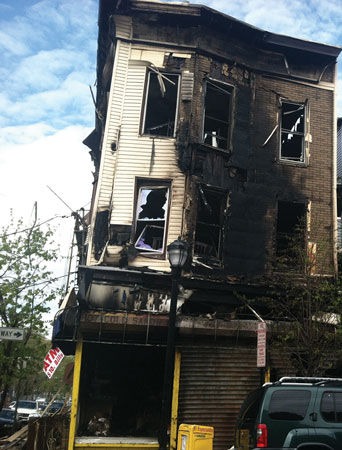 |
| (1) The structural carcass. This braced-frame building was gutted from an overnight fire and was also leaning. Personnel and apparatus were removed from the area while awaiting the demolition crew’s arrival. (Photos 1-3 by author). |
Conduct a very careful and pessimistic risk analysis when considering whether to enter the interior or the collapse danger zone of these structural carcasses. Once the building is damaged to the point of imminent collapse, stay away. For some reason, we are pretty good at maintaining collapse zones during defensive operations, but once the streams are shut down, we are often oblivious to the danger that still exists. Remember, at this point, the building is at its weakest, after having been beaten up by fire and firefighting operations. Just because the fire is out, we do not have the green light to operate carelessly (photo 3).
When I discussed this in a class once, a student told me that his department only did it if there was a report of an unaccounted-for person, meaning a body. They would go and have gone inside to conduct secondary searches to ensure the body is found and removed before the building is demolished. Really? Run that type of risk for a body? In that situation, you should secure the area and possibly isolate it from the public. Under the supervision and direction of the incident commander (IC) and maybe a structural engineer, the demolition crews can dismantle the building. This dismantling would require removing debris to a “drop point” where, in a safe area, properly protected personnel could sift through the rubble. FDNY Deputy Chief (Ret.) Vincent Dunn calls it “general debris removal.” Once it is on the ground where it can fall nowhere, debris from unstable upper floors that were previously under a precariously damaged roof is much safer to search.
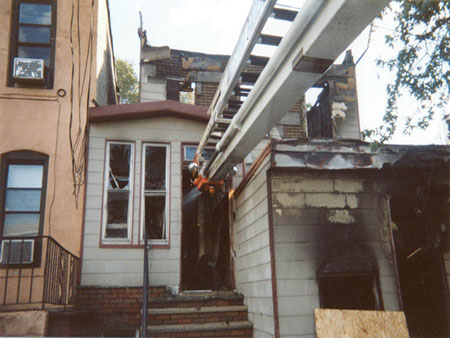 |
| (2) This building received a hydraulic overhaul before a “bulldozer facial.” Although the boom was in the collapse zone, the entire rear of the building was already gone, so the collapse danger is minimal. Still, personnel were kept out and no casualties occurred. |
Utility Control
This “keep out of the danger zone” mentality also applies to two other postcontrol activities. When controlling utilities, do not permit utility personnel shutting off the structure’s electricity, gas, or water supply to do so inside the collapse zone. Ideally, the utility would prefer not to disrupt service to other customers and would just isolate the dangerous structure. The options for this are either to dig up the street in front to get at the shutoff or to place a utility truck in front of the structure to shut off the electricity at the pole where the service connect supplies electricity to the building. The IC’s responsibility is to ensure everyone goes home, including the public. If the utilities have to be shut down from a remote area that is out of danger, then that is what must be done, at least until the building comes down and is no longer a danger. If you were proactive and had notified a demolition company as soon as you knew this structure was going to be a loser, you might have minimized that inconvenience time to customers. Developing a good working relationship with the utility companies through meetings and response agreements before the incident will also assist in mutually cooperative decision making and understanding (photo 4).
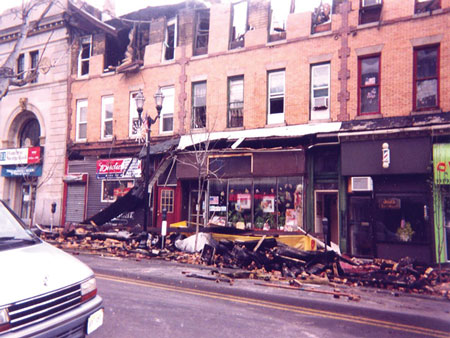 |
| (3) The parapet and cornice of these structural carcasses collapsed without warning, peeling away all at once. A fire line and fire watch had been set up and no one was in the collapse zone when it occurred. |
Tenant Exclusion
This blanket exclusion policy also carries over to two other constituents, the tenants and the police. Tenants often want to get back into the building to retrieve valuables and medications. Always try to accommodate this-when you can-and only if the building and the situation allow it. A structural carcass does not. Unfortunately, you must stick to your guns here, and be empathetic but firm. District politicians or the police might at times try to intervene on behalf of a citizen (i.e., taxpayer, voter). Again, be firm. You are responsible, and the danger and any consequences fall on your shoulders. Holding a meeting with politicians and the police before a fire is one way to explain why we do not want their taxpayers in harm’s way when this situation presents itself. Debating the question in the street makes no one look good.
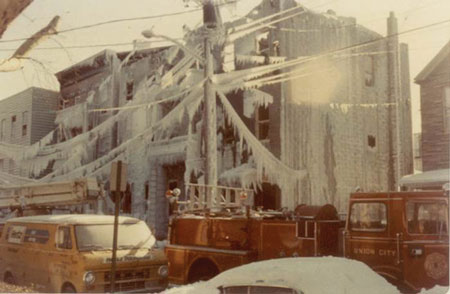 |
| (4) These two structural carcasses collapsed after the ice melted. The weight of ice on both of these buildings and the power lines presented a double threat. In such a situation, cut off the power from a remote location and maintain collapse zones until the building comes down, whether on its own or with the help of a demolition company. These apparatus should have been moved out of the way, too. (Photo by Ron Jeffers.) |
Traffic Control
One of the police department’s main objectives is to keep the traffic moving, which might mean allowing traffic to flow in front of a damaged and unstable building. Traffic vibrations might be enough to bring the structure down. Remember, you can never predict when a building will collapse. If it is a narrow street such as the streets found in urban areas like northern Hudson County, New Jersey, you might want to maintain control of the street and the incident until the danger has passed and keep the street closed. The police or the mayor might not like this, but as long as the fire department is on scene, the scene belongs to the department. Use that control to ensure the safety of the public. If the street is wide enough, it might be feasible, after you have consulted a structural engineer, to open one side to traffic; leave the side closest to the structure closed. There is no hard-and-fast rule here, but the common sense rules of public safety should guide your decisions. Whatever you allow, you will be buying, so keep yourself, the department, and the public protected (photo 5).
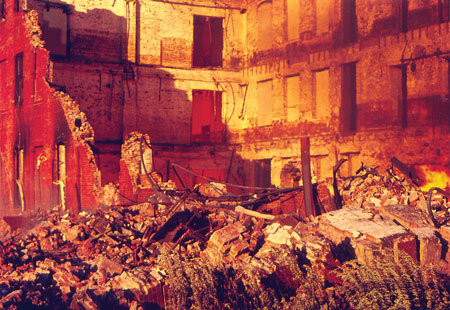 |
| (5) Masonry wall structural carcasses are much more perilous than wood frame, but either one can kill your personnel. Once the floors go, the remaining walls are nothing more than a free-standing house of cards. Here, the wall has collapsed, which can result from traffic vibrations. (Photo courtesy of author.) |
Fire Investigation
Another consideration is the fire investigation and the personnel it involves. In some cases, you may need to preserve a carcass structure for a fire investigation, especially in the case of multiple fatalities. In such circumstances, a structural engineer and a shoring contractor will need to come to the scene. Command cannot let its guard down just because a fire investigation must be conducted. It still must maintain all scene safety parameters, ensure established collapse zones are respected and reinforced, and continuously assess and manage risk throughout the entire operation. The structural engineer will establish what is possible and what is not in terms of stabilizing and entering the building. Based on the building’s damage and the danger, an early preliminary exterior investigation including firefighter interviews may be the only activity that can be conducted. A structural engineer can also help coordinate a “selective demolition” in which a dangerous portion of the structure is removed to provide for a safer examination of an “area of interest.” Many fire investigators have been injured and killed by a collapse during an investigation, long after the fire has been extinguished. Don’t allow anyone to risk their necks tonight for something that will be put in a dump truck and hauled away tomorrow. Coordination between the incident commander, the local building official, the fire investigation team, the structural engineering experts, and the demolition and/or stabilization contractors is imperative.
Equipment Removal
Finally, when removing equipment from the scene, do so with caution. Moving apparatus shouldn’t be an issue since you should have established defensive collapse zones during operations. If apparatus are an issue, move them to the flanks or out of the way altogether. Hose and other equipment may still be in front and behind and in the alleys alongside the damaged structure. Possibly you can uncouple hoselines at remote safe areas and drag them away from areas you do not want firefighters to enter. Additional equipment may not be movable at this point, so you will need to wait until after building demolition to retrieve them. Again, enforce keeping personnel out of established collapse zones around structural carcasses when removing hose and equipment as long as the danger exists. The demobilization and the safety officers must be well-versed in operational parameters and ensure the safety zones are clearly identified, enforced, and maintained.
Fire departments must have policies in place that guide actions if an operation will eventually result in an unsafe structure. Command; control; accountability; and, most of all, discipline on the part of those on the fireground make for a safer fireground. Establishing and training on procedures before the incident and enforcing policy as long as these dangerous potential collapse conditions exist help to ensure that no unnecessary casualties will occur. As always, the chief of department is responsible for this issue-if he does not think it is important, neither will anyone else.
ANTHONY AVILLO, a 30-year veteran of the fire service, retired from North Hudson (NJ) Regional Fire as a deputy chief. He is the director and deputy fire marshal of the Monmouth County (NJ) Fire Academy and an adjunct professor at New Jersey City University. Avillo has bachelor’s and a master’s degree in fire science. He is a member of the educational advisory boards of FDIC International and Fire Engineering. Avillo is the author of Fireground Strategies, second edition (2015), and collaborated on the Tactical Perspectives DVD series (Fire Engineering). He was the 2012 Fire Engineering/ISFSI George D. Post Instructor of the Year.
Structural Collapse : The Hidden Dangers of Residential Fires
Understanding and Preparing for Structural Firefighting Phases
Drill of the Week: Overhaul Safety
Fire Engineering Archives

